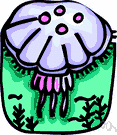cnidarian
Also found in: Thesaurus, Medical, Encyclopedia, Wikipedia.
cni·dar·i·an
(nī-dâr′ē-ən)n.
Any of various invertebrate animals of the phylum Cnidaria, characterized by a radially symmetrical body with a saclike internal cavity and stinging nematocysts, and including the jellyfishes, hydras, sea anemones, and corals.
[New Latin Cnīdāria, phylum name, from Greek knīdē, sea nettle.]
cni·dar′i·an adj.
American Heritage® Dictionary of the English Language, Fifth Edition. Copyright © 2016 by Houghton Mifflin Harcourt Publishing Company. Published by Houghton Mifflin Harcourt Publishing Company. All rights reserved.
cnidarian
(naɪˈdɛərɪən; knaɪ-)n
(Animals) any invertebrate of the phylum Cnidaria, which comprises the coelenterates
adj
(Animals) of, relating to, or belonging to the Cnidaria
[C20: from New Latin Cnidaria, from Greek knidē nettle]
Collins English Dictionary – Complete and Unabridged, 12th Edition 2014 © HarperCollins Publishers 1991, 1994, 1998, 2000, 2003, 2006, 2007, 2009, 2011, 2014
cni•dar•i•an
(naɪˈdɛər i ən)n.
1. any radially symmetric invertebrate of the phylum Cnidaria, including the hydras, jellyfishes, sea anemones, and corals, characterized by stinging cells and a saclike digestive cavity with a single opening surrounded by tentacles. Compare coelenterate.
adj. 2. of or pertaining to the cnidarians.
Random House Kernerman Webster's College Dictionary, © 2010 K Dictionaries Ltd. Copyright 2005, 1997, 1991 by Random House, Inc. All rights reserved.
cni·dar·i·an
(nī-dâr′ē-ən) Any of various invertebrate animals that have a body with radial symmetry, tentacles, and a sac-like internal cavity. They have a single opening for ingesting food and eliminating wastes. Cnidarians include the jellyfishes, hydras, sea anemones, and corals. Also called coelenterate.
The American Heritage® Student Science Dictionary, Second Edition. Copyright © 2014 by Houghton Mifflin Harcourt Publishing Company. Published by Houghton Mifflin Harcourt Publishing Company. All rights reserved.
ThesaurusAntonymsRelated WordsSynonymsLegend:
Switch to new thesaurus
| Noun | 1. |  cnidarian - radially symmetrical animals having saclike bodies with only one opening and tentacles with stinging structures; they occur in polyp and medusa forms cnidarian - radially symmetrical animals having saclike bodies with only one opening and tentacles with stinging structures; they occur in polyp and medusa formscoelenteron - the saclike body cavity of a coelenterate invertebrate - any animal lacking a backbone or notochord; the term is not used as a scientific classification Cnidaria, Coelenterata, phylum Cnidaria, phylum Coelenterata - hydras; polyps; jellyfishes; sea anemones; corals polyp - one of two forms that coelenterates take (e.g. a hydra or coral): usually sedentary with a hollow cylindrical body usually with a ring of tentacles around the mouth; "in some species of coelenterate, polyps are a phase in the life cycle that alternates with a medusoid phase" medusan, medusoid, medusa - one of two forms that coelenterates take: it is the free-swimming sexual phase in the life cycle of a coelenterate; in this phase it has a gelatinous umbrella-shaped body and tentacles jellyfish - any of numerous usually marine and free-swimming coelenterates that constitute the sexually reproductive forms of hydrozoans and scyphozoans scyphozoan - any of various usually free-swimming marine coelenterates having a gelatinous medusoid stage as the dominant phase of its life cycle actinozoan, anthozoan - sessile marine coelenterates including solitary and colonial polyps; the medusoid phase is entirely suppressed |
Based on WordNet 3.0, Farlex clipart collection. © 2003-2012 Princeton University, Farlex Inc.
Translations
žahavec
cnidario